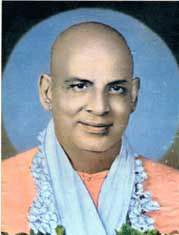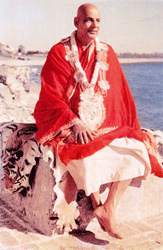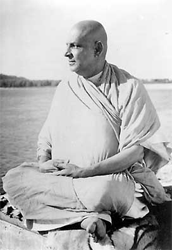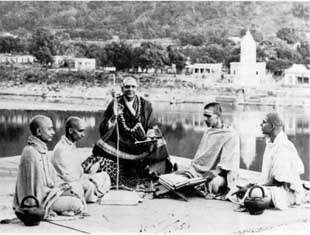Swami Sivananda
 ”He practised medicine for 10 years. When he was 35, his wife and one child died. At that point he dropped everything and set off, sleeping in the road, begging from door to door, from Singapore to Himalaya. He suffered of rheumatism and malaria for two years, but he cured himself through yoga techniques. Now he is happy because there is no pain, no separation, no death for him, because dualism is not real anymore and because the only reality is Brahman-Atman, the soul, which is the same in the human being and in the Universe.” (Mircea Eliade)
”He practised medicine for 10 years. When he was 35, his wife and one child died. At that point he dropped everything and set off, sleeping in the road, begging from door to door, from Singapore to Himalaya. He suffered of rheumatism and malaria for two years, but he cured himself through yoga techniques. Now he is happy because there is no pain, no separation, no death for him, because dualism is not real anymore and because the only reality is Brahman-Atman, the soul, which is the same in the human being and in the Universe.” (Mircea Eliade)
He was always the first.
On Thursday, the 8th of September, during the first hours of the morning, when the Bharani star was at the ascendant, a boy was born, in the Pattamadani village, on the bank of the Tamraparani river, in the South of India. Sri Vendu Iyer, financial administrator and a great Shiva Bhakta (worshipper of Shiva) and Srimati Parvati Ammal, a very religious woman were the happy parents of this child (the third and the last ) who was named Kuppuswamy.
The boy, intelligent and naughty, proved from his first years that his path was called tyaga (giving up). He loved people and he manifested compassion towards the poors. He often took cakes and candies from the house and gave them to his friends, but also to his dogs, cats, sparrows, without touching them at all. Also, he used to bring flowers for Shiva’s adoration ritual, Shiva Puja, performed by his father.
Kuppuswamy was always the first and won prizes every year at the superior school from Ettayapuram, where he studied. He had a very pleasant voice and an exceptional memory. He studied at the Tiruchirapalli college, where he participated always in conferences and plays.
The faculty was attended at the medical school in Tanjore, using unusual will and effort. His holidays were spent at the hospital also, where he had obtained the permission to enter the operation unit, all the time. He was always the first in any exam, and he had more knowledge than any of the most well respected doctors, being able to answer, from his first year of faculty, to questions for which the senior students didn’t even have the smallest information.
After graduating faculty, he practised medicine at Tiruchi, when he published a medical journal that he often distributed freely, and for which he didn’t ask for any financial contribution.
 He had the healing gift
He had the healing gift
Soon after his father’s death, he was asked to work as a doctor in Malaysia, so that he left India in 1913: “Fortunately for me, -he states- Mr. Robbins needed an assistant who could work at the hospital, at that time. He asked me if I was able to run a hospital by myself, and I immediately replied that I am capable of running three hospitals at the same time.”
Kind, pleasant, full of a sense of humour, and oratorical skills, doctor Kuppuswamy successfully treated and solved cases that seemed hopeless. Regardless of the city where they were, the patients declared the same thing: that he received from God the wonderful gift of healing and kindness, plus charisma and an impressive personality. When there were serious situations, he would stay up all night, and as for the poors, he didn’t turn his back on them, but he would give them money for food, many times, or for the hospital fees. His heart was as pure as the Himalaya snow. His sacrifice and abandoning nature made him very lovable. People called him dearly, “The Spirit of Love”.
Although he was very busy at the hospital, Kuppuswamy always took care of the sadhu, sannyasin andbeggars. Once a sadhu asked him a book, Jiva Brahma Aikyam by Sri Swami Satchidananda, and awoke his spiritual interest, which had been potential until that time. This was the beginning; after that he studied the books of Swami Rama Tirtha, Swami Vivekananda and Sankara, books as ImitatioChrist, the Bible and the books of the Theosophical Society. He practised postures and praying on a daily basis, and he profoundly and passionately studied the sacred texts such as Bhagava- Gita, Mahabharata, and Ramayana. Sometimes, he would perform devotional songs, in a sacred manner. He practised different types of yoga, among which secret Svara techniques.
He was reborn through an abandoning service
After an intense activity, doctor Kuppuswamy gave up the world – following Prince Siddartha’s model – and in 1923, he left Malaysia heading towards India. His soul had been purified through the disinterested, profoundly selfless service, for the people and through spiritual practices as well.
He began his pilgrimage at Madras. In Benares he had the vision (darshan) of Visvanath. He visited the great masters and the temples. The significant moment for his spiritual evolution is connected to the date of May, 8, 1924, when he got to Rishikesh and he found his spiritual master. On the 1st of June 1924, he was initiated by Paramahamsa Vishwananda Saraswati, in the sannyas order, receiving the name of Swami Sivananda Sarasvati. Swami Vishnudevanandaji Maharaj, the leader of Sri Kailas ashram, conducted the Viraja Homa ceremonies, and Swami Sivananda stayed in Swargashram in order to perform his sadhana (spiritual practice).

He used to meditate 12 hours per day
Swami Sivananda lived to serve humanity. A small, damaged and isolated hut, full of scorpios kept him away from rain and wind. In that particular spot he performed powerful tapas, there he listened to the silence and fasted. Sometimes he used to fast for days. He used to store some bread in the house and that was it, for a week, next to Ganges’s water. During the cold winter mornings, he lied in the ice cold water of the sacred river and started his Jappa; he came out of the river, only after the sunrise. He spent more than 12 hours in meditation, daily. The tapas never prevented Swamiji from taking care of the sick people. He used to visit the huts of the sadhu, having medicines on him; he helped them and washed their feet. He blessed the food on their behalf, and fed them with his hands when they felt sick. He brought them water from Ganges and cleaned them their huts. He cured cholera and smallpox cases. When it was necessary, he watched the sick people all the time, or carried them on his back in the hospital. In 1927, he founded a charity clinic, at Lakshmanjula, using the money he had saved.
He travelled all around India and visited important pilgrimmage places from the south, including Rameswaram. He reached Sri Aurobindo ashram and met Suddhananda Bharati Maharishi. In the Ramana ashram, he had the vision (darshan) of sri Ramana Maharishi, on the latter’s birthday. He sang Bhajanas and danced until he reached ecstasy, along with Ramana bhakta. Then he left for a journey to Kailas-Manasrovar and Badri. Swamiji had always paper and pen with him, in order to write down his revelations and the work methods, useful in the spiritual practice, which shortly became true teachings.
He practised all types of yoga and he studied the holy books. After years of intense and ceaseless sadhana, he was blessed with the state of Nirvikalpa Samadhi, reaching the end of his spiritual journey.
 He awoke people’s souls
He awoke people’s souls
After the pilgrimage he returned to Rishikesh, and in 1936 he founded the society called The Divine Life, on the banks of the Ganges. Today the society is the centre and the headquarters of an international organisation, with a large number of branches both in India and in other countries, and its main objective is spreading the spiritual knowledge and the disinterested service offered to humanity. The free distribution of the spiritual writings brought a constant group of disciples to Sivananda. The world was facing the second world war and, in order to release a beneficial peace impulse around the world, to help the positive orientation of the badly affected world thinking, he initiated the Akhana Mahamantra Kirtan, that is the continuous spelling of the sacred incantation: Hare Rama Hare Rama/ Rama Rama HareHare / Hare KrishnaHareKrishna / KrishnaKrishnaHareHare for a number of days. This spiritual endeavour started on December, the 3rd and continued till December, 31, 1943.
Because he felt the need to help people with ayurvedic remedies, made of Himalaya’s plants, he founded Sivananda Ayurvedic Pharmacy, in 1945; it had a great impact on the population, and in a very short time it couldn’t cover the demands. Swami Sivananda’s small clinic developed slowly and became a permanent hospital. Sivananda Hospital for eye problems opened in December 1957, having 10 beds and growing until 30. Swami Sivananda founded the Federation of All Religions in the World on December 28, 1945 and the Sadhu Federation from the entire world on February, 12, 1947. The Vedanta –Yoga Academy was set up in 1948 to offer all the sadhaka (disciples) residents a systematic spiritual training, and to offer genuine yoga teachings to the spiritual seekers who visited the Academy.
Swami Sivananda undertook a spiritual journey in 1950, throughout the entire India and Ceylon, in order to make his divine message known. He awoke people’s souls to a new, truly divine life. The impact was overwhelming. Since then, a flow of spiritual seekers and a lot of letters from the disciples from the country, who asked him a broader spreading of his teachings, were continuously addressed to the ashram. In September 1951, The Editorial League was founded, as a powerful way of popularizing the spiritual teachings and the Master’s writings all around the world; the disciples were eager to research his entire work. This favoured the foundation of the Research Institute of Sivananda’s Literature, in 1958, who among other things, decided that his work should be translated and published systematically in all India’s dialects, and establishing a regional committee for each of them.
Swami Sivananda spread his divine message about altruism. Meditation and communion to the divine reached all the world’s corners, through almost 300 books, through journals and letters. His devoted disciples belong to all the religions, cults and sects in the world. His yoga – significantly entitled Yoga of the synthesis – provides a harmonious development through the practice of Karma Yoga (The disinterested action yoga), Jnana Yoga (Yoga of the Mind or of the Spiritual knowledge) and Bhakti Yoga (Yoga of the Heart, of the ardent love for God).
On the 14th of July 1963, the great soul Swami Sivananda entered Mahasamadhi in his hut on the bank of the Ganges, in Sivanandanagar.
An article from Yoga Magazin Magazine, no. 18
yogaesoteric
Also available in:
 Română
Română
